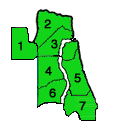
THE HIGH PERFORMANCE TREE SERVICE TEAM YOU CAN DEPEND ON
IN FLEMING ISLAND FLORIDA


THIS IS HOW PAPER BEATS ROCK
HEADLINE: HUNGRY TREE EATS BICYCLE
Physical Repair.
A tree wound often appears ragged where the bark is torn during the injury. This is common during branch breakage and when the trunk of the tree has been scraped. To repair this type of damage, cut off any ragged bark edges with a sharp knife. Take care not to remove any healthy bark and expose more live tissue than necessary. If possible, the wound should be shaped like an elongated oval, with the long axis running vertically along the trunk or limb. All bark around the wound should be tight.
Wound Dressings.
Research indicates that wound dressings (materials such as tar or paint) do not prevent decay and may even interfere with wound closure. Wound dressings can have the following detrimental effects:
- Prevent drying and encourage fungal growth
- Interfere with formation of wound wood or callus tissue
- Inhibit compartmentalization
- Possibly serve as a food source for pathogens
Wound dressings do not stop decay or prevent entrance of decay mechanisms. Covering wounds with sealants inhibits the oxidation processes, which in turn will reduce callus formation and compartmentalization. For these reasons, applying wound dressings is not recommended. Trees, like many organisms, have their own mechanisms to deter the spread of decay organisms, insects and disease.
Cavity Filling.
Filling of large holes or hollows in the tree is generally done for cosmetic reasons. There is little data to indicate that a filled tree has better mechanical stability. However, fillings may give the callus tissue a place to seat, thus stopping the in-roll (folding) of the callus.
Almost any filling can be used as long as it does not abrade the inside of the tree. The filling of a tree cavity is generally expensive and not recommended. The filling does not stop decay and often during the cleaning of the cavity, the boundary that separates the sound wood or the callus growth from the decayed wood is ruptured. Thus, this cleaning for cavity filling can have more detrimental effects on the tree than if it were left alone. Care must be taken not to damage the new callus tissue that has formed in response to the tree damage and subsequent decay.

